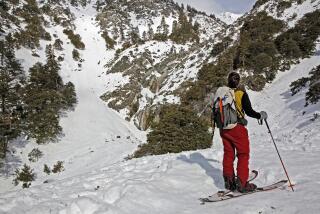Shop for snowshoes like a pro
If you’ve spent time wandering through deep untracked snow, you may have entertained the idea of stepping into a pair of snowshoes.
By strapping on the shoes, deep, snow-packed landscapes suddenly become open to adventure.
“It’s one of the most beautiful ways to see the wilderness,” Claire Walter, a lifelong snowshoer and Colorado snowshoe guidebook author, likes to say.
If the shoes look complicated and intimidating, know that appearances are deceiving.
By adding surface area to each foot, the shoe is able to distribute weight more evenly across the snow, thus keeping the wearer from sinking deeply into the snowpack.
“People sometimes don’t expect to sink down when walking,” Ryan Alford, editor and publisher of Snowshoe magazine, told me last month while snowshoeing through an untouched drift.
“But the truth is the shoes will help users sink only a foot or two in deep powder, instead of 4 or 5 feet, which could be dangerous.”
Here’s how to get started:
Understand the different types of snowshoes. The three general categories: aerobic, recreational and expedition-style snowshoes.
“Aerobic snowshoes tend to have a smaller footprint and are made of lighter material,” said Mary Stuber, an associate with outdoor retailer REI.
The short size provides runners increased agility and speed.
Recreational snowshoes are typically a bit larger and provide more flotation and stability.
Expedition snowshoes are the semis of snowshoes and are built like tanks. These shoes are designed to handle extremely heavy loads and keep users safe while navigating extreme terrain. They’re also the most expensive of the three types, so Stuber suggests making sure you really need them before spending the money.
Study the anatomy of a snowshoe. Although each snowshoe may have a slightly different purpose, the anatomy of the shoe remains consistent.
Thinking about snowshoes as bindings, decking and traction plates will help you select the right kind and keep within your budget.
“Bindings are designed to fit over your waterproof boots,” Stuber said at an in-store clinic last month in Boulder, Colo. “Unlike skiing or snowboarding, you don’t have to go out and buy new shoes, but you should try them on with your boots to find the one that works for you.”
Bindings are designed by each manufacturer, so Stuber emphasized that new snowshoers should try the bindings before buying the shoes.
“Bring in your boots to the store and try them on a few times,” Stuber said.
The decking, constructed of plastic, neoprene or Hypalon, helps snowshoers float on top of the snow.
When selecting the right type of decking, it’s important to look at price. “Usually the more expensive the snowshoe, the more durable the decking,” Stuber noted.
The third component is the shoe’s traction plates, or “crampons,” in industry terms. These crampons provide traction on icy slopes and steep terrain and keep the shoe from generally sliding around.
Recreational snowshoes typically have two or three traction points; expedition shoes can have traction around the entire frame.
“If you’ve got a big pack on and don’t want to slip back, this is what you need,” Stuber said. “Otherwise, if you’re just snowshoeing on packed trail, a less aggressive shoe will work fine.”
Find the right trail for your skill level. Snowshoeing can be dangerous if hikers veer into avalanche-prone areas or wander off the trail, but guidebooks and online resources can help.
Several websites, including https://www.snowshoemag.com and https://www.snowshoes.com, provide trip reports, first-time check lists and trail recommendations, and are great resources for beginner to advanced snowshoers.
“Another great way to get started is to find a guided snowshoe hike,” said Walter, the guidebook author. “National parks, outdoor clubs and some retailers offer them to the public.”
Other avenues include attending a snowshoe clinic at a local outdoor store or participating in one of the store’s specialty programs.
“There are a lot of ways to get out and snowshoe,” Walter said. “But the most important is just getting out there and enjoying the snow.”
More to Read
Sign up for The Wild
We’ll help you find the best places to hike, bike and run, as well as the perfect silent spots for meditation and yoga.
You may occasionally receive promotional content from the Los Angeles Times.






